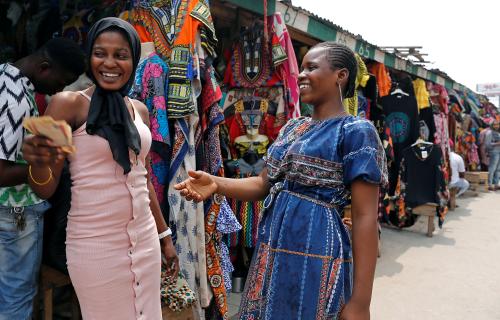South Asia is booming. In 2018, GDP growth for the region as a whole is expected to accelerate to 6.9 percent, making it the fastest growing region in the world. However, fast GDP growth has not translated into fast employment growth. In fact, employment rates have declined across the region, with women accounting for most of this decline.
Between 2005 and 2015, female employment rates declined by 5 percent per year in India, 3 percent per year in Bhutan, and 1 percent per year in Sri Lanka. While it is not surprising for female employment rates to decline with economic growth and then increase, in what is commonly known as the U-shaped female labor force function (a term coined by Claudia Goldin in 1995), the trends observed in South Asia stand out. Not only has female employment declined much more than could have been anticipated, it is likely to decline further as countries such as India continue to grow and urbanize.
The unusual trend for female employment rates in South Asia is clear from Figure 1. While male employment rates in South Asia are in line with those of other countries at the same income level, female employment rates are well below.
Figure 1: Female employment rates in South Asia are low
Source: South Asia Economic Focus (Spring 2018).
If women are choosing to exit the labor force as family incomes rise, should policymakers worry? There are at least three reasons why the drop in female employment rates may have important social costs. First, household choices may not necessarily match women’s preferences. Those preferences reflect the influence of ideas and norms about what is women’s work and men’s work as well as other gendered notions such as the idea that women should take care of the children and housework. Second, when women control a greater share of household incomes, children are healthier and do better in school. Third, when women work for pay, they have a greater voice in their households, in their communities, and in society. The economic gains from women participating equally in the labor market are sizable: A recent study estimated that the overall gain in GDP to South Asia from closing gender gaps in employment and entrepreneurship would be close to 25 percent.
What advice should one give policymakers in South Asia if the goal is to increase female employment? Many types of gender interventions to improve female employment and earnings have been tried and tested in the region—from support for female entrepreneurs to programs to facilitate access to finance, to specialized skills training. Yet, as we see from the falling employment figures, the programs do not seem to be working. At best, they have had modest impacts. Should policymakers keep trying new variants of gender-focused interventions until they finally find the right fit?
Continued experimentation and evaluation of gender–targeted interventions that aim to support female employment is important and necessary, if policymakers are to identify policies that work. Promising new interventions include, for example, personal initiative training to create an entrepreneurial mindset, which successfully increased incomes of female entrepreneurs in settings as different as West Africa and Peru. However, if the goal is to increase women’s employment, why not target the barriers that constrain employment (whether they are gender specific or not) rather than women themselves? In other words, instead of assuming that interventions should focus on women, try to focus on the interventions that make the biggest difference to women. Many of these may well appear to be gender-neutral in targeting but are not gender neutral in impact. Here are some crucial examples.
Electricity access. Evidence suggests that rural electrification can have a strong positive impact on the living conditions and well-being of families, as well as a positive impact on local economic growth. The impacts are bigger for women, who face greater time constraints and bear the burden of household chores. In the book In the Dark: How Much Do Power Sector Distortions Cost South Asia?, Fan Zhang reports that women’s labor force participation in Bangladesh is 7 percentage points higher in households connected to the electricity grid than in comparable off-grid households. For Pakistan, the difference is 2 percentage points. Access to electricity improves the lives of women in other ways too—increasing the time they spend on studies, reducing the time spent collecting biofuel, and reducing the days lost to illness.
Trade. Lukewarm integration into the global economy in South Asia has led to an economic structure that does not match the countries’ comparative advantage, with their vast supplies of relatively unskilled labor. Greater openness and integration into global markets in labor-intensive sectors such as apparel and garments could have an enormous impact on employment in the region, and on female employment especially since these sectors tend to be intensive in female labor. The 2012 World Development Report: Gender Equality and Development found a strong correlation between openness to international trade and female employment in developing countries. Bangladesh, a country that has become a global powerhouse in garment exports, is the one country in South Asia that has not experienced a decline in female labor force participation. The comparative advantage of South Asia in unskilled labor goods should become even stronger as wages in China rise. In From Stiches to Riches, Gladys Lopez Acevedo and co-authors estimate that a 10 percent increase in apparel prices in China would increase female employment in the apparel sector by 8 percent in Pakistan, 7 percent in Sri Lanka, 5 percent in India, and 4 percent in Bangladesh.
Physical connectivity. Integrated and efficient transport networks can play a big role in stimulating economic development. The impacts go well beyond the lowering of travel and transport costs, and work through changes in trade, migration, and agglomeration effects. Economic corridors can attract investment, facilitate the emergence of new jobs in manufacturing and services, and support exports. Through these channels, in turn, they create new, good jobs for women and prove beneficial to female employment. One recent study suggests that India’s Golden Quadrilateral accelerated women’s shift out of farms and into non-farm employment.
The bottom line is that the biggest boost to women’s employment and economic empowerment in South Asia may not always come from policies that focus specifically on women. Most likely, it will come from policies and investments that address key development constraints that often are especially detrimental to women. These policies and investments may well appear gender-neutral on the surface, but they are not gender-neutral in their impact. Bringing a gender lens to decision making around these policies and investments will not only increase their development impact, it will also put gender at the core of a country’s development policy instead of at the periphery.








Commentary
How to boost female employment in South Asia
June 12, 2018